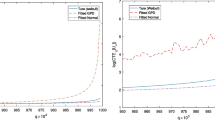Abstract
New risks seem to be an unavoidable in a period of rapid change. The last few decades have brought us the risks of global warming, nuclear meltdown, ozone depletion, failure of satellite launcher rockets, collision of supertankers, AIDS and Ebola.l A key feature of a new risk, as opposed to an old and familiar one, is that one knows little about it. In particular, one knows little about the chances or the costs of its occurrence. This makes it hard to manage these risks: existing paradigms for the rational management of risks require that we associate probabilities to various levels of losses. This poses particular challenges for the insurance industry, which is at the leading edge of risk management. Misestimation of new risks has lead to several bankruptcies in the insurance and reinsurance businesses.2 In this paper we propose a novel framework for providing insurance cover against risks whose parameters are unknown. In fact many of the risks at issue may be not just unknown but also unknowable: it is difficult to imagine repetition of the events leading to global warming or ozone depletion, and, therefore, difficult to devise a relative frequency associated with repeated experiments.
We are grateful to Peter Bernstein, David Cass and Frank Hahn for valuable comments on an earlier version of this paper.
Access this chapter
Tax calculation will be finalised at checkout
Purchases are for personal use only
Preview
Unable to display preview. Download preview PDF.
Similar content being viewed by others
Reference
Arrow, K. J. “The Role of Securities in an Optimal Allocation of Risk-Bearing”, in Econometrie, Proceedings of the Colloque sur les Fondements et Applications de la Theorie du Risque en Econometrie, Paris, Centre National de la Recherche Scientifique, 1953, pp. 41–48. English translation in Review of Economic Studies 31, 1964, 91–96.
Arrow, K. J. and R. C. Lind. “Uncertainty and the Evaluation of Public Investments”, American Economic Review 60, 1970, 364–378.
Chichilnisky, G. “Catastrophe Bundles Can Deal with Unknown Risks”, Bests’ Review, February 1996, 1–3.
Cass, D., G. Chichilnisky and H. M. Wu. “Individual Risks and Mutual Insurance”, CARESS Working Paper No. 91–27, Department of Economics, University of Pennsylvania, 1991.
Chichilnisky, G. and H. M. Wu. “Individual Risk and Endogenous Uncertainty in Incomplete Asset Markets”, Working Paper, Columbia University and Discussion Paper, Stanford Institute for Theoretical Economics, 1991.
Chichilnisky, G. and G. M. Heal. “Global Environmental Risks”, Journal of Economics Perspectives 7(4), 1993, 65–86.
Chichilnisky G., J. Dutta and G. M. Heal. “Price Uncertainty and Derivative Securities in General Equilibrium”, Working Paper, Columbia Business School, 1991.
Chichilnisky, G., G. M. Heal, P. Streufert and J. Swinkels. `Believing in Multiple Equilibria“, Working Paper, Columbia Business School, 1992.
Debreu, G. The Theory of Value, New York, Wiley, 1959.
Debreu, G. “Economies with a Finite Set of Equilibria”Econometrica38, 1970, 387–392.
Dierker, E. “Regular Economies”, in Handbook of Mathematical Economics, Vol. II, Chapter 17, K. J. Arrow and M. D. Intrilligator, eds., Amsterdam, North-Holland, 1982, pp. 759–830.
Gary, M. R. and D. S. Johnson. Computers and Intractability: A Guide to NP-Completeness,New York, W.H. Freeman and Company, 1979.
Geanakoplos, J. “An Introduction to General Equilibrium with Incomplete Asset Markets”, Journal of Mathematical Economics 19, 1990, 1–38.
Heal, G. M. “Risk Management and Global Change”, Paper presented at the First Nordic Conference on the Greenhouse Effect, Copenhagen, 1992.
Malinvaud, E. “The Allocation of Individual Risk in Large Markets”, Journal of Economic Theory 4, 1972, 312–328.
Malinvaud, E. “Markets for an Exchange Economy with Individual Risk”, Econometrica 3, 1973, 383–409.
Editor information
Rights and permissions
Copyright information
© 1998 Springer Science+Business Media Dordrecht
About this chapter
Cite this chapter
Chichilnisky, G., Heal, G. (1998). Financial Markets for Unknown Risks. In: Chichilnisky, G., Heal, G., Vercelli, A. (eds) Sustainability: Dynamics and Uncertainty. Fondazione Eni Enrico Mattei (FEEM) Series on Economics, Energy and Environment, vol 9. Springer, Dordrecht. https://doi.org/10.1007/978-94-011-4892-4_14
Download citation
DOI: https://doi.org/10.1007/978-94-011-4892-4_14
Publisher Name: Springer, Dordrecht
Print ISBN: 978-94-010-6051-6
Online ISBN: 978-94-011-4892-4
eBook Packages: Springer Book Archive




